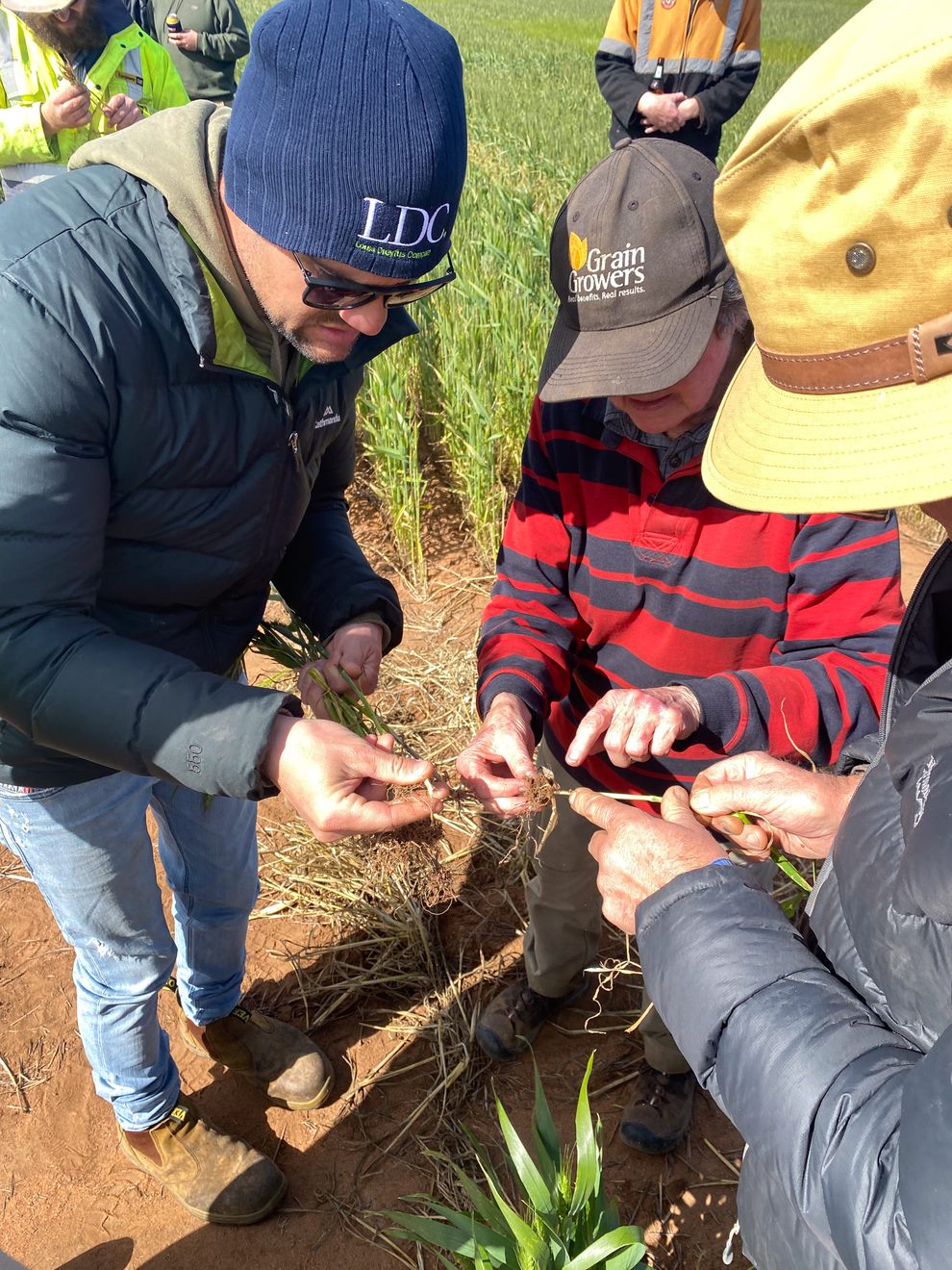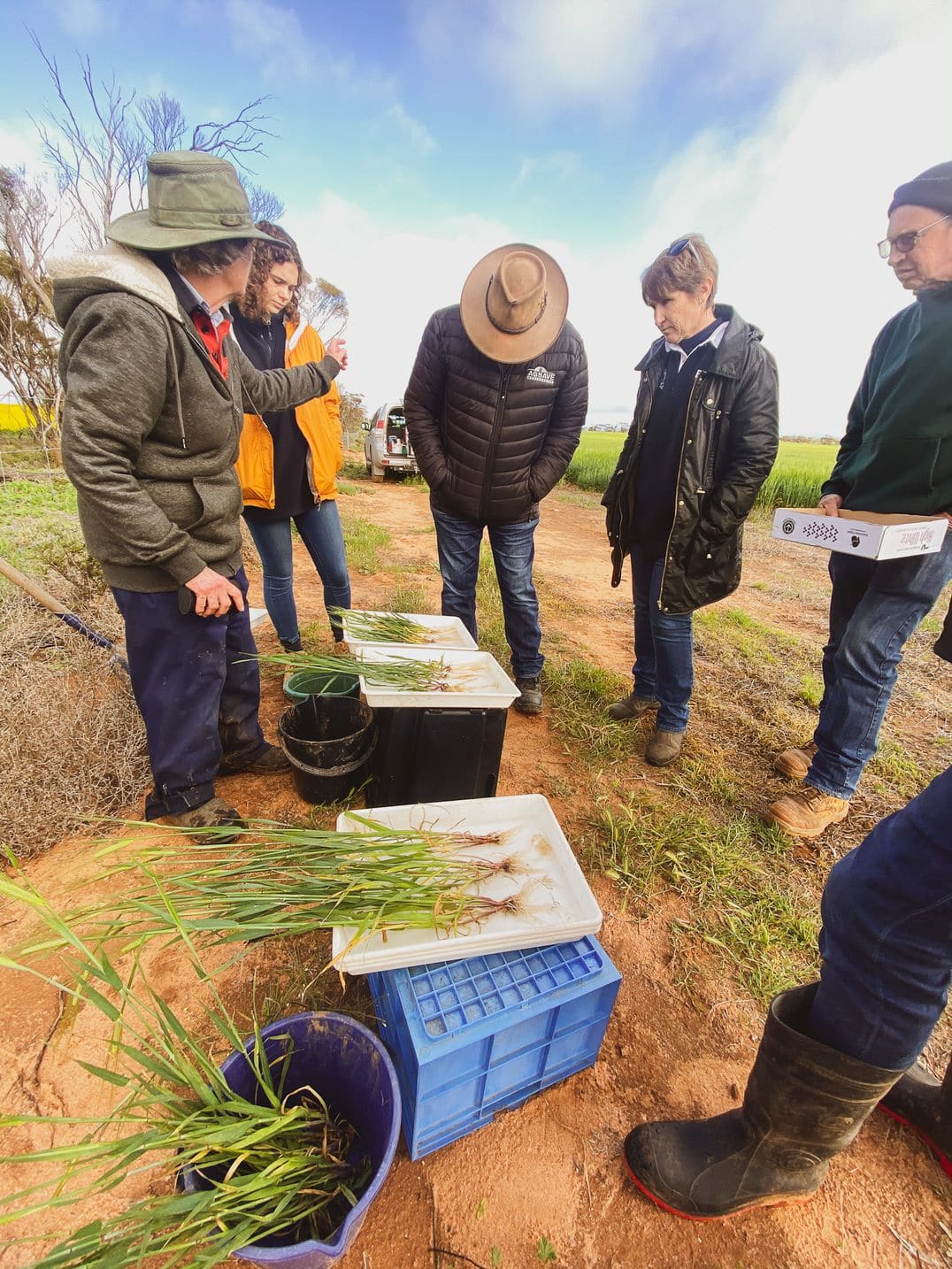Managing crown rot on upper EP – a joint learning experience
Project Plan
Project activities will build on knowledge gained from prior research on Upper EP using trials and complementary grower-sown demonstrations with the objectives being to:
1. Reduce yield losses due to crown rot, so increasing the amount and consistency of grain quantities available for export.
2. Improve the consistency of cereal grain production and the profitability of cereal enterprises on UEP.
3. Increase adoption of existing (used in conventional and novel ways) and novel options for managing crown rot.
4. Improve the ability of farmers and advisors (and researchers) to understand trials and demonstrations and how to interpret the results for application and implementation in local farming systems.
2022 Field Trials Take-home messages
Field trials and demonstrations were established at Buckleboo and Mitchellville on Upper Eyre Peninsula, with an Elders-funded matching trial in the Upper North at Booleroo Centre, value-adding to the SAGIT project.
Mild conditions during flowering and grain filling meant there was no white head expression due to crown rot, although basal stem browning was present.
There were small, statistically significant average yield improvements at Mitchellville (3%) and Booleroo Centre (7%) where Victratoâ fungicide was applied to seed, but there were no variety:fungicide interactions.
In general, bread wheat entries included for their (possibly) improved resistance to crown rot had lower yields than other entries.
In a season with high soil moisture at sowing, sowing deep to “chase moisture” reduced yield (by 5%) of four long coleoptile varieties but did not affect yield of Calibre (longer coleoptile).
Information about the project and its findings were provided to Industry during crop walks at the Buckleboo and Mitchellville sites and, at their request, at the Baroota UNFS crown rot management site.
A tailored, field-based capacity building activity based around cereal root and stem-base diseases resulted in a wide range of learnings for participants.
Successful in-field evaluation of the above activity provided a joint learning experience for the presenter and participants. As a result, a tailored activity has been designed for growers and a process developed to trial for improving the capability and confidence of participants in identifying cereal root and stem-base diseases.
The project and its findings were publicised outside Eyre Peninsula by presenting at a UNFS crown rot management trial at Baroota and by running a modified cereal root and stem-base diseases activity at the Hart twilight walk.
Industry capacity to undertake crown rot research was improved by assisting and providing training for those running crown rot trials for the Hart Field Site Group and the Upper North Farming Systems group. This included visual assessment of treatment plots, taking plant samples, counting white heads, processing samples and scoring basal stem browning.
2023 Field Trials Take-home messages
A total of 5 replicated trials and two large-plot demonstrations were established at Buckleboo and Mitchellville on Upper Eyre Peninsula in 2023.
Limited moisture stress during flowering and grain filling in 2023 resulted in some basal stem browning as well as some white head expression due to crown rot.
Positive average yield responses to VICTRATO® were seen in bread wheat (1%-11%) and barley (7%-12%) in 2022 and 2023, despite limited crown rot expression. This is consistent with lower-end responses at medium and high rainfall sites in South Australia.
Visual inspection of 2023 data and statistical analysis of 2022 data indicates that varietal responses to VICTRATO® will be similar, regardless of varietal maturity and resistance rating.
These findings make VICTRATO® a useful addition to the strategies currently available for crown rot management. It is clear VICTRATO® should not be used as a stand-alone option, but will best be pyramided with other management options where there is a known risk of yield loss from crown rot.
Yield improvements due to VICTRATO® won’t produce the yield that could be achieved in the absence of crown rot and you may still see white heads where VICTRATO® is applied.
At Mitchellville in 2023, a combination of season, soil and site conditions disadvantaged the barley yield response (average 22% yield decrease) to VICTRATO® due to good early growth promoted by VICTRATO® in the presence of crown rot. This result was unexpected and is unlikely to occur often in barley and rarely in bread wheat due to their different tillering habits.
Consider the economics of VICTRATO® using t/ha responses. For example (Scepter) – a 10% yield improvement at Buckleboo in 2022 (untreated yield = 3.91 t/ha) = 0.39 t/ha but in 2023 (untreated yield = 1.56 t/ha) = 0.15 t/ha. No difference in % yield change (which is used to compare across sites, years and treatments) but a big difference in economics.
VICTRATO® slightly reduces severity but not visual incidence of crown rot on main stem bases which suggests a large reduction in inoculum carryover is unlikely. To better understand this effect of VICTRATO®, dedicated trials were established in 2023 and crown rot risk levels will be assessed in 2024 using PREDICTAâ B.
2024 Field Trials Take-home messages
Effects of VICTRATO® (registration pending as at Dec 2024) in the low rainfall environment of Upper Eyre Peninsula begin with reductions in crown rot incidence and severity, leading to yield and profitability improvements in-crop and some reduction in inoculum carryover to the next season. The immediate yield and profitability outcomes combined with the longer-term effect on crown rot inoculum will make VICTRATO® a useful addition to current crown rot management strategies.
VICTRATO® is not a ‘silver bullet’ and should not be used as a stand-alone option, but should be combined with other crown rot management strategies. VICTRATO® will not return yields to those seen in the absence of crown rot and white head expression can still occur in crops where seed was treated.
Yield response to VICTRATO® was not affected by bread wheat variety (maturity or crown rot resistance ratings), so variety selection can be made on the basis of general performance. Sowing deep to “chase moisture” also did not influence yield response to VICTRATO®, so deep sowing can be used if surface soil is dry.
Deep sowing reduced both plant establishment and yield. Consider increasing sowing rate when planning to sow deep to chase moisture.
VICTRATO® has the potential to increase use of PREDICTA B as it means there is a management option available for immediate use if PREDICTA B results show there is a significant risk of yield loss due to crown rot.
Large plot demonstrations are better undertaken by:
- Sowing (no gaps between runs) and managing them with research equipment.
- Having a small unsown gap between treatment areas to facilitate sampling etc.
- Alternating controls with treatments and sampling along each plot to identify spatial trends, so ensuring that treatment effects are interpreted correctly.
Small trial plots show similar crown rot expression to that in larger areas, giving confidence treatment effects will be correctly interpreted in small plot trials.
Simple evaluation methods can be used for field-based workshops (bulls-eye target) and for research projects (semi-structured discussions). These methods engage participants (unlike written sheets) and provide valuable feedback for developing workshops and for planning and running projects.
Share this project:
You Might Also Like
Future Drought Fund Long Term Trials SA Discovery Farms – Sustainable phosphorous strategies for Eyre Peninsula
AIR EP has partnered with SA Discovery Farms, with co-investment by SAGIT, in a new project aimed at improving P fertiliser applications in variable paddocks/landscapes and refining long-term management strategies…
Learn MoreYoung Farmer Peer to Peer Learning Lower EP 2025
AIR EP will establish a group comprised of Lower Eyre Peninsula young farmers (~18-35 years). This group will participate in three field events/workshops featuring speakers on topics that build agricultural,…
Learn MoreBuilding resilience – Break Crop Suitability Across Landscapes (Stage 2)
Upper North Farming Systems and AIR EP have worked to bring this common theme across the 3 farming groups and 4 Node regions together into the one project in 2024.…
Learn MoreRisky decisions and addressing soil constraints on EP
This project has two key objectives that address the priorities of the SA Drought Hub 1. Arming farmers and advisors with tools to assist in decision making that considers risk…
Learn MoreGrowing lentils on challenging soils on Eyre Peninsula
A new 3-year project has been funded by GRDC to explore growing lentils on ‘challenging’ soils across EP. The project, led by AIR EP will fund 4 trials per year,…
Learn MoreDe-risking the sowing program on EP in 2025
SA Drought Hub Project Page
Learn MoreUnderstanding herbicide residue on challenging soil types within the southern region
To develop a better understanding of the nature and scope of herbicide residues issues, paddock surveys will be conducted in soil types of concern in SA. To determine phyto-toxicity thresholds,…
Learn MoreEyre Peninsula internship in applied grains research 2026
To improve the capacity of grains research, development and extension in the Eyre Peninsula region through the employment of an annual intern within local research organisations in 2026. Hosted by…
Learn MoreSustainable Agriculture: Driving growth through innovation and climate responsive practices.
The Eyre Peninsula Sustainable Agriculture Program brings together Agricultural Innovation & Research Eyre Peninsula (AIR EP), the EP Landscape Board, key researchers, industry specialists, and local organisations to deliver a…
Learn MoreImproving crop phosphorus supply on highly calcareous soils using novel sources
This project will develop integrated solutions to improve the delivery of P in challenging calcareous soils with multiple constraints. Those solutions will be developed in a farming systems context so…
Learn More

